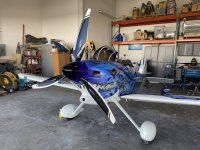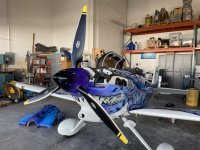On with the the New:

Off with the Old:

So our RV-3 (“Tsamsiyu”) has been flying since day one with a Whirlwind 151 three-blade prop (the one with the yellow tips). Fabulous propeller - light weight, constant speed, great aerodynamics - that gave us tremendous performance, both in cruise and climb. The airplane will climb 3,000 fpm at sea level, or run down the ocean beach flat out faster than the airframe was designed to go (if you let it). But….nothing lasts forever.
The 151 was one of Jim Rust’s early designs, and he has learned a lot in more than a decade, refining both aerodynamics and mechanics to the point where the 151 has been discontinued in favor of the newer 300 Series (the one with the white tips). And since the 151 was discontinued, he doesn’t have any parts for routine servicing or overhaul. So…..it was only matter of time before it became an expensive paperweight, and since I’ve been very happy with the 300 on our RV-8 for a year, Jim made us a good deal on a new prop for the RV-3.
I flew the airplane down to El Cajon (just east of San Diego) yesterday in cold temperatures (and great tailwinds), arriving about 10:30. By 12:30, the airplane was ready to fly with the new nose! Kudos to Jim and his team, as well as to painter/artist extraordinaire John Stahr who pre-painted the spinner to match the rest of the airplane before the prop was ready. I flew the airplane back to Big Bear for the night, and headed home this morning. Got lucky with tailwinds both ways…..
I didn’t take any solid flight test data, but based on knowing the airplane, I think it is a couple, maybe three knots faster at normal cruise settings in the low teens. We balanced it before leaving El Cajon, and the installation is wonderfully smooth. Climb with this airplane is always outstanding, so I’ll have to do some careful measurements on a calm day to se what kind of improvement we got, but based on previous testing with the -300, I expect to see an extra 10% or so.
The prop certainly looks bigger (it is 70” while the old one was 68”), with a bit broader chord, and Jim said that watching it as I taxied away, it looks powerfully big. And the carbon fiber look is stunning up close.
We’ll see how the 6 lbs extra on the nose feels for aerobatics once it warms up around here!
Paul

Off with the Old:

So our RV-3 (“Tsamsiyu”) has been flying since day one with a Whirlwind 151 three-blade prop (the one with the yellow tips). Fabulous propeller - light weight, constant speed, great aerodynamics - that gave us tremendous performance, both in cruise and climb. The airplane will climb 3,000 fpm at sea level, or run down the ocean beach flat out faster than the airframe was designed to go (if you let it). But….nothing lasts forever.
The 151 was one of Jim Rust’s early designs, and he has learned a lot in more than a decade, refining both aerodynamics and mechanics to the point where the 151 has been discontinued in favor of the newer 300 Series (the one with the white tips). And since the 151 was discontinued, he doesn’t have any parts for routine servicing or overhaul. So…..it was only matter of time before it became an expensive paperweight, and since I’ve been very happy with the 300 on our RV-8 for a year, Jim made us a good deal on a new prop for the RV-3.
I flew the airplane down to El Cajon (just east of San Diego) yesterday in cold temperatures (and great tailwinds), arriving about 10:30. By 12:30, the airplane was ready to fly with the new nose! Kudos to Jim and his team, as well as to painter/artist extraordinaire John Stahr who pre-painted the spinner to match the rest of the airplane before the prop was ready. I flew the airplane back to Big Bear for the night, and headed home this morning. Got lucky with tailwinds both ways…..
I didn’t take any solid flight test data, but based on knowing the airplane, I think it is a couple, maybe three knots faster at normal cruise settings in the low teens. We balanced it before leaving El Cajon, and the installation is wonderfully smooth. Climb with this airplane is always outstanding, so I’ll have to do some careful measurements on a calm day to se what kind of improvement we got, but based on previous testing with the -300, I expect to see an extra 10% or so.
The prop certainly looks bigger (it is 70” while the old one was 68”), with a bit broader chord, and Jim said that watching it as I taxied away, it looks powerfully big. And the carbon fiber look is stunning up close.
We’ll see how the 6 lbs extra on the nose feels for aerobatics once it warms up around here!
Paul




